-
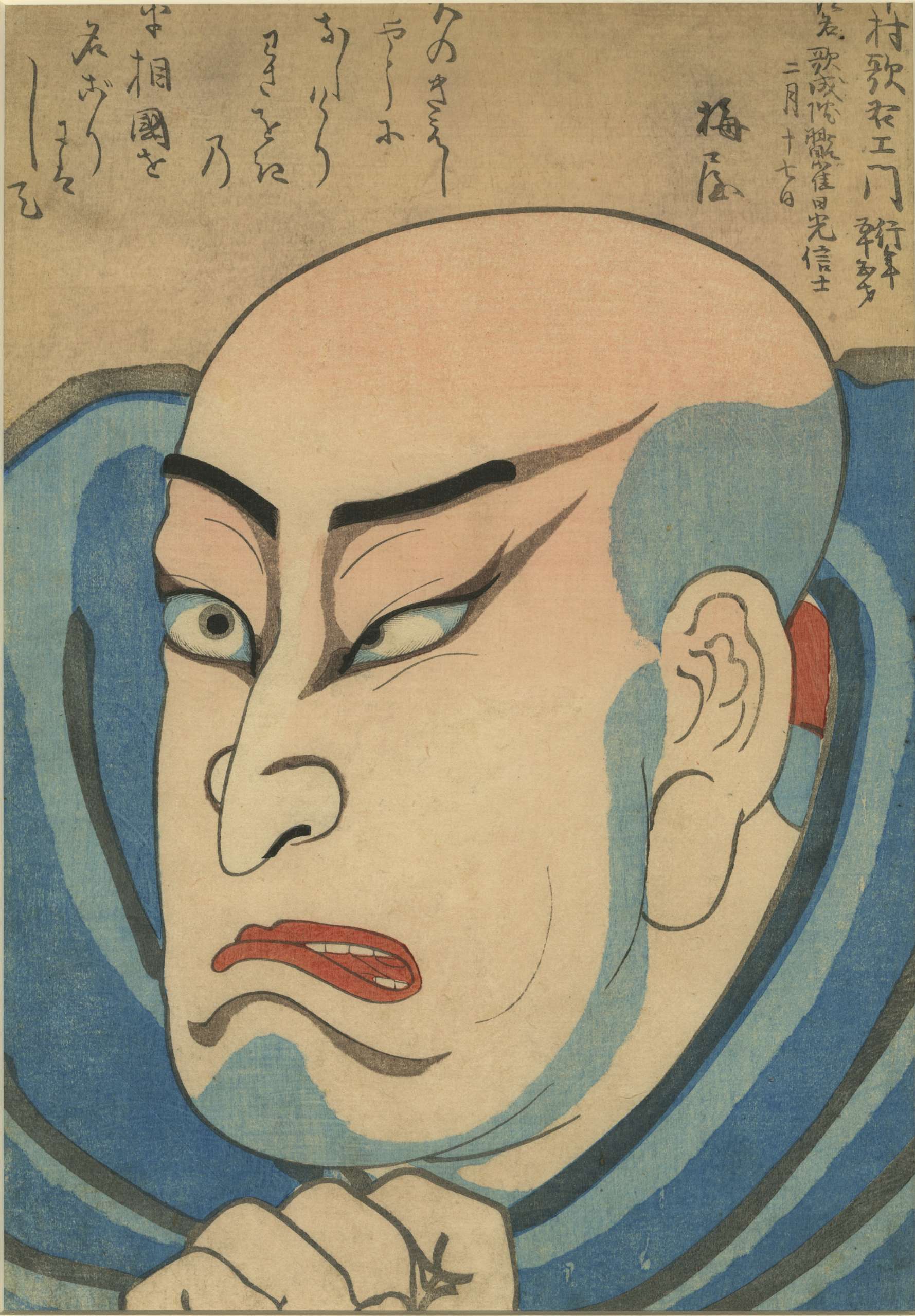 Utagawa Kuniyoshi, 歌川 国芳, January 1, 1797 – April 14, 1861. Memorial portrait (Shini-e) of Nakamura Utaemon IV as a priest. Date: 1852. Reference: Heroes and Ghosts, by Robert Schaap, 1998, p. 165 (image 176). Tokyo digital museum 番号 94202582. Provenance: Herbert Egenolf Collection, Germany. Literature: Suzuki (1992) 317. Trimmed, unsigned.
Utagawa Kuniyoshi, 歌川 国芳, January 1, 1797 – April 14, 1861. Memorial portrait (Shini-e) of Nakamura Utaemon IV as a priest. Date: 1852. Reference: Heroes and Ghosts, by Robert Schaap, 1998, p. 165 (image 176). Tokyo digital museum 番号 94202582. Provenance: Herbert Egenolf Collection, Germany. Literature: Suzuki (1992) 317. Trimmed, unsigned. -
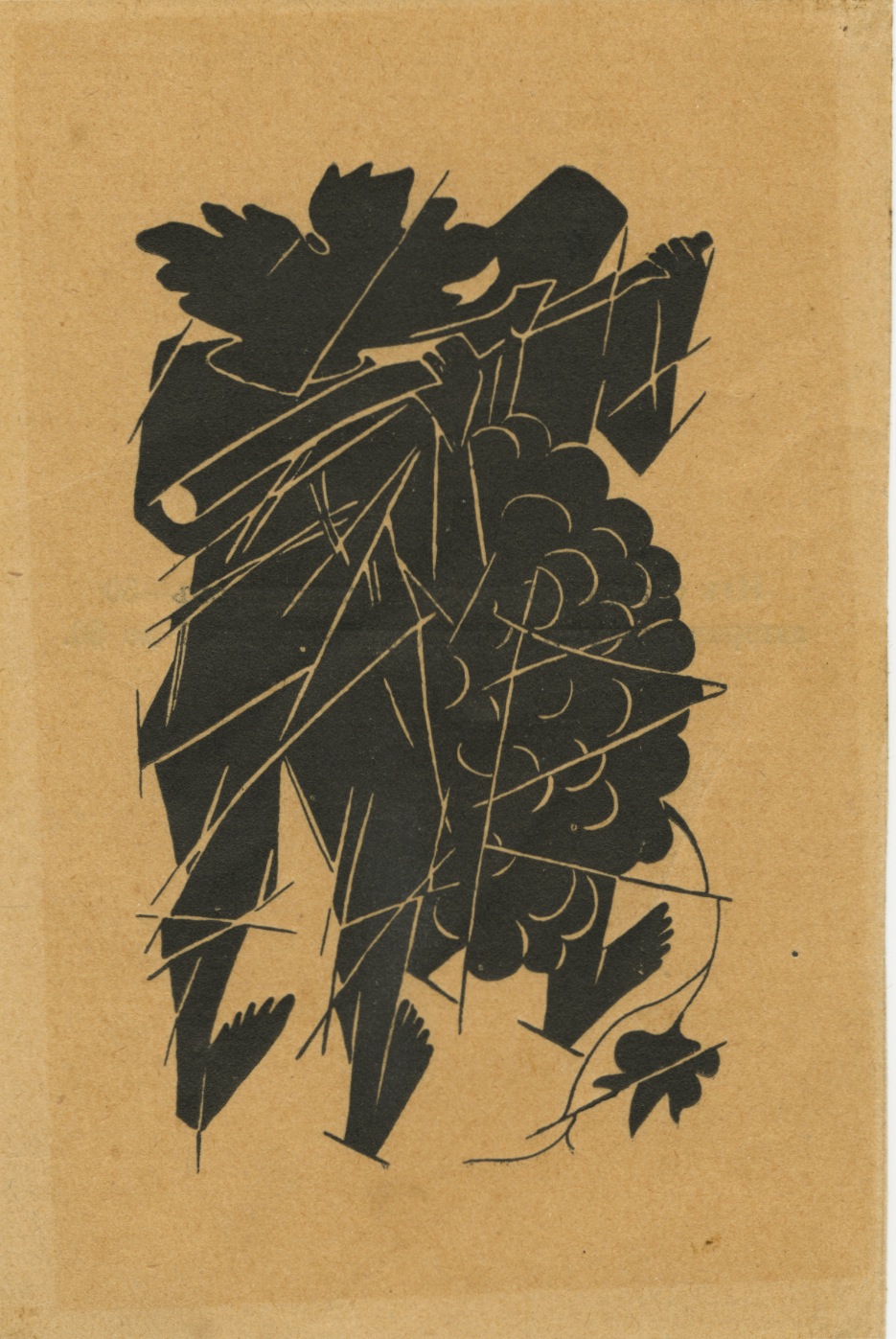 Artist: Natalia Goncharova (July 3, 1881 – October 17, 1962). Russian/French. Lithographic illustration (frontispiece) for Sergei Bobrov book of poetry "The gardeners upon the grapevines", Moscow, Lirika Publishers, 1913. Size: 18 х 11,5 cm.
Artist: Natalia Goncharova (July 3, 1881 – October 17, 1962). Russian/French. Lithographic illustration (frontispiece) for Sergei Bobrov book of poetry "The gardeners upon the grapevines", Moscow, Lirika Publishers, 1913. Size: 18 х 11,5 cm.Book was printed on May 20, 1913 for Lirika Publishers, by V. I. Voronov printshop in 500 copies, of them 50 authored and numbered. 10 lithographs by Natalia Goncharova printed at Kushneryov & Co. lithography in Moscow.
Наталия Гончарова (3 июля 1881 – 17 октября 1962). Россия/Франция. Литографическая иллюстрация (фронтиспис) к книге С. П. Боброва "Вертоградари над лозами" [Сергей Бобров. М.: /Лирика, 1913]. Формат: 18 х 11,5 см.Тираж 500 экз, из них 50 авторизованных и нумерованных. Десять цветных рисунков работы Н. Гончаровой исполнены в технике литографии на отдельных листах. Книга отпечатана 20 мая 1913 года в типографии В.И. Воронова для книгоиздательства «Лирика». В мягкой издательской обложке. На с. 162 после списка литографий: Отпечатаны литографией т-ва И.Н. Кушнерев и К° в Москве.
-
 Utagawa Kunisada [歌川 国貞]; a.k.a. Utagawa Toyokuni III [三代歌川豊国] (Japanese, 1786 – 1865). Signed: Toyokuni ga [豊国 画] in a red toshidama cartouche. Publisher: Ibaya Senzaburō [伊場屋仙三郎] (Japanese, fl. 1815 – 1869). Block carver: Yokokawa Takejirō [横川竹二郎] (Japanese, fl. 1845 – 1863), seal: 彫竹 – Hori Take. Date seal and aratame censor seal: May of the Year of Dragon [辰五] (Tatsu-go) (5/1856) (Not in Marks).
Utagawa Kunisada [歌川 国貞]; a.k.a. Utagawa Toyokuni III [三代歌川豊国] (Japanese, 1786 – 1865). Signed: Toyokuni ga [豊国 画] in a red toshidama cartouche. Publisher: Ibaya Senzaburō [伊場屋仙三郎] (Japanese, fl. 1815 – 1869). Block carver: Yokokawa Takejirō [横川竹二郎] (Japanese, fl. 1845 – 1863), seal: 彫竹 – Hori Take. Date seal and aratame censor seal: May of the Year of Dragon [辰五] (Tatsu-go) (5/1856) (Not in Marks). Uncut fan print (uchiwa-e) depicting Onoe Kikugorō IV as Karukaya Dōshin parting from his son, Ishidomaru (played by Ichimura Uzaemon XIII), and Kawarasaki Gonjūrō I as Yamazakiya Yogoro in the kabuki play Karukaya Dōshin Tsukushi no Iezuto [苅萱桑門筑紫𨏍], written by Namiki Sōsuke [並木宗輔] (Japanese, 1695 – 1751) and performed at Ichimuraza [市村座] in 05/1856.
Media: Fan print [団扇絵] (Uchiwa-e); size: 235 x 305 mm.
Actors:
Onoe Kikugorō IV [四代目 尾上菊五郎] (Japanese, 1808 – 1860); other names: Onoe Baikō IV, Onoe Eizaburō III, Onoe Kikue, Nakamura Tatsuzō, Nakamura Kachō.
Onoe Kikugorō V [五代目尾上菊五郎] (Japanese, 1844 – 1903 other names: Onoe Baikō V, Ichimura Kakitsu IV, Ichimura Uzaemon XIII [十三代目市村羽左衛門], Ichimura Kurōemon.
Ichikawa Danjūrō IX [市川団十郎] (Japanese, 1838 – 1903); other names: Kawarasaki Sanshō, Kawarasaki Gonnosuke VII, Kawarasaki Gonjūrō I, Kawarasaki Chōjūrō III.
Plot: It was a popular belief at one time that jealous women had their hair transformed into writhing serpents and Kato Sayemon Shige-Uji, a daimyo of Tsukushi, a much-married man, suffered from the delusion that his wife was so affected. He fled to the mountains to escape her and led the life of a hermit under the name of Karukaya Doshin [苅萓道心]. One day, on Mount Kōya (高野山, Kōyasan) Karukaya meets a young man who was wandering in the mountains. Being questioned, the youth tells his name, Ishidomaru, and elicits the information that he is seeking his lost father. Karukaya then recognizes the boy as his own son, but firm in the resolve to remain lost to the world, he refrains from disclosing himself, and bids the youth return home.
Provenance: Paul F. Walter (American, 1935 – 2017).
Ref.:
Uncut fan print (uchiwa-e) depicting Onoe Kikugorō IV as Karukaya Dōshin parting from his son, Ishidomaru (played by Ichimura Uzaemon XIII), and Kawarasaki Gonjūrō I as Yamazakiya Yogoro in the kabuki play Karukaya Dōshin Tsukushi no Iezuto [苅萱桑門筑紫𨏍], written by Namiki Sōsuke [並木宗輔] (Japanese, 1695 – 1751) and performed at Ichimuraza [市村座] in 05/1856.
Media: Fan print [団扇絵] (Uchiwa-e); size: 235 x 305 mm.
Actors:
Onoe Kikugorō IV [四代目 尾上菊五郎] (Japanese, 1808 – 1860); other names: Onoe Baikō IV, Onoe Eizaburō III, Onoe Kikue, Nakamura Tatsuzō, Nakamura Kachō.
Onoe Kikugorō V [五代目尾上菊五郎] (Japanese, 1844 – 1903 other names: Onoe Baikō V, Ichimura Kakitsu IV, Ichimura Uzaemon XIII [十三代目市村羽左衛門], Ichimura Kurōemon.
Ichikawa Danjūrō IX [市川団十郎] (Japanese, 1838 – 1903); other names: Kawarasaki Sanshō, Kawarasaki Gonnosuke VII, Kawarasaki Gonjūrō I, Kawarasaki Chōjūrō III.
Plot: It was a popular belief at one time that jealous women had their hair transformed into writhing serpents and Kato Sayemon Shige-Uji, a daimyo of Tsukushi, a much-married man, suffered from the delusion that his wife was so affected. He fled to the mountains to escape her and led the life of a hermit under the name of Karukaya Doshin [苅萓道心]. One day, on Mount Kōya (高野山, Kōyasan) Karukaya meets a young man who was wandering in the mountains. Being questioned, the youth tells his name, Ishidomaru, and elicits the information that he is seeking his lost father. Karukaya then recognizes the boy as his own son, but firm in the resolve to remain lost to the world, he refrains from disclosing himself, and bids the youth return home.
Provenance: Paul F. Walter (American, 1935 – 2017).
Ref.:
- [LIB-2110.2019] Samuel L. Leiter. Historical Dictionary of Japanese Traditional Theatre (Historical Dictionaries of Literature and the Arts). / 2nd edition. – Lanham: Rowman & Littlefield, 2014; pp. 379-380.
- [LIB-2206.2019] Basil Stewart. Subjects portrayed in Japanese colour-prints. — London: Kegan Paul, Trench, Trubner & Co. Ltd., 1922.
-
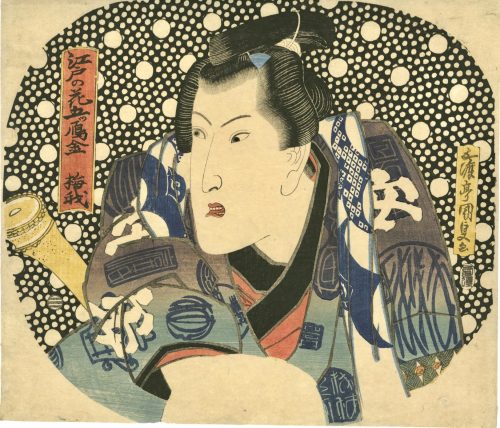 Artist: Utagawa Kunisada, a.k.a. Toyokuni III (Japanese, 1786 – 1865) [歌川 国貞]. Publisher: Ibaya Senzaburō [伊場屋仙三郎] (Japanese, fl. C. 1845 – 1847). Date aratame seal: Bunsei 12 (1829). Signed: Gototei Kunisada ga [五渡亭国貞画]. Media: Fan print (uchiwa-e), 272 x 235 mm. Actor: Iwai Hanshirō VI (Japanese, 1799 – 1836); other names: Iwai Hanshirō VI, Iwai Kumesaburō II, Iwai Hisajirō I, Baiga [梅我] (poetry name), Shūka (poetry name). The background is Arare-ko-mon [霰小紋] hail pattern. Kabuki actor Iwai Kumesaburō II in the role of An no Heibei [安の平兵衛] in the drama Otokodate Itsutsu Karigane [男作五雁金] (Play, 7 acts. Produced 1742/09). From Lyon collection: The real An no Heibei (ca. 1672-1702): "In a gang with Kaitate no Kichiemon, Hote no Ichiemon, Mippiki Jihei and others as of the Seventh Month of 1697. Attacked people with a sword on the sixth day, Seventh Month, 1699, which he then secreted with Kichiemon. On the evening of the sixth day, Sixth Month, 1701, stabbed Kibei, an employee of Kawachiya Gohei of the residential quarter Kyuhoji, in the side with a dagger. A subsequent police investigation resulted in Heibei's arrest the following day. Beheaded at the execution grounds located at Sennichi Mae on the twenty-sixth day of the Eighth Month, 1702." Note: According to Horst Graebner, the actor's name below the series title in the cartouche is Baiga (梅我), the poetry name of Iwai Kumesaburō II. On the other prints in this series, the actors are also named on the other prints with their poetry names. In the red cartouche at the top left is the series title "Edo no hana – itsutsu Karigane" (江戸の花 五雁金), to be translated as "Flowers of Edo - the five Karigane blood-brothers" (or "the five Karigane gang members"). "Since there was no performance with the Karigane brothers from 1829, these must be mitate prints", states Mr Graebner.
Artist: Utagawa Kunisada, a.k.a. Toyokuni III (Japanese, 1786 – 1865) [歌川 国貞]. Publisher: Ibaya Senzaburō [伊場屋仙三郎] (Japanese, fl. C. 1845 – 1847). Date aratame seal: Bunsei 12 (1829). Signed: Gototei Kunisada ga [五渡亭国貞画]. Media: Fan print (uchiwa-e), 272 x 235 mm. Actor: Iwai Hanshirō VI (Japanese, 1799 – 1836); other names: Iwai Hanshirō VI, Iwai Kumesaburō II, Iwai Hisajirō I, Baiga [梅我] (poetry name), Shūka (poetry name). The background is Arare-ko-mon [霰小紋] hail pattern. Kabuki actor Iwai Kumesaburō II in the role of An no Heibei [安の平兵衛] in the drama Otokodate Itsutsu Karigane [男作五雁金] (Play, 7 acts. Produced 1742/09). From Lyon collection: The real An no Heibei (ca. 1672-1702): "In a gang with Kaitate no Kichiemon, Hote no Ichiemon, Mippiki Jihei and others as of the Seventh Month of 1697. Attacked people with a sword on the sixth day, Seventh Month, 1699, which he then secreted with Kichiemon. On the evening of the sixth day, Sixth Month, 1701, stabbed Kibei, an employee of Kawachiya Gohei of the residential quarter Kyuhoji, in the side with a dagger. A subsequent police investigation resulted in Heibei's arrest the following day. Beheaded at the execution grounds located at Sennichi Mae on the twenty-sixth day of the Eighth Month, 1702." Note: According to Horst Graebner, the actor's name below the series title in the cartouche is Baiga (梅我), the poetry name of Iwai Kumesaburō II. On the other prints in this series, the actors are also named on the other prints with their poetry names. In the red cartouche at the top left is the series title "Edo no hana – itsutsu Karigane" (江戸の花 五雁金), to be translated as "Flowers of Edo - the five Karigane blood-brothers" (or "the five Karigane gang members"). "Since there was no performance with the Karigane brothers from 1829, these must be mitate prints", states Mr Graebner. -
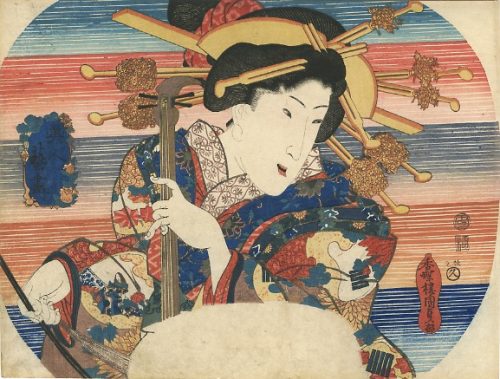 A young woman playing a four-string musical instrument with a bow (kokyū). Series: Assortments of Beauties Accomplishments [美人芸盡] (Bijin gei-zukushi). Utagawa Kunisada [歌川 国貞]; a.k.a. Utagawa Toyokuni III [三代歌川豊国] (Japanese, 1786 – 1865). Signed: Kochoro Kunisada ga [香蝶楼 国貞画] in a red double gourd cartouche. Publisher: Ibaya Kyūbei [伊場屋久兵衛] (Japanese, 1804 – 1851); seal: Hanmoto, Kyū [板元久] (Marks 19-040 | 126e) Date seal: Bunsei 12 (1829). Censors' seal: Kiwame. Size: Fan print (uchiwa-e).
A young woman playing a four-string musical instrument with a bow (kokyū). Series: Assortments of Beauties Accomplishments [美人芸盡] (Bijin gei-zukushi). Utagawa Kunisada [歌川 国貞]; a.k.a. Utagawa Toyokuni III [三代歌川豊国] (Japanese, 1786 – 1865). Signed: Kochoro Kunisada ga [香蝶楼 国貞画] in a red double gourd cartouche. Publisher: Ibaya Kyūbei [伊場屋久兵衛] (Japanese, 1804 – 1851); seal: Hanmoto, Kyū [板元久] (Marks 19-040 | 126e) Date seal: Bunsei 12 (1829). Censors' seal: Kiwame. Size: Fan print (uchiwa-e). -
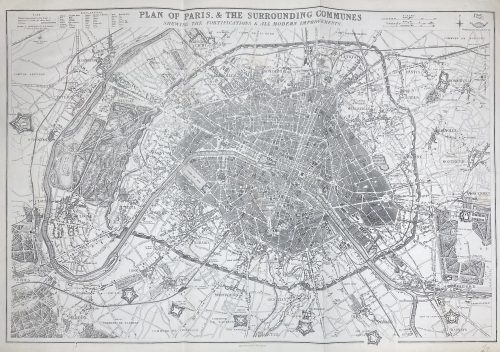 PLAN OF PARIS & THE SURROUNDING COMMUNES | SHEWING THE FORTIFICATIONS & ALL MODERN IMPROVEMENTS. || Lettered above the image with title, and below with production detail: "Day & Son, Lithrs to the Queen"; and production detail above: "Drawn & Engraved by B.R. Davies: / 16 George Str Euston Squ London", and on top right: "Weekly Dispatch Atlas, 138 Fleet Str". Dimensions: 47.5 x 65.4 cm. Contributors: Day & Son; William Day (British, 1797 – 1845) – lithographer, printer. Davies, Benjamin Rees (British, 1789 – 1872) – artist, engraver.
PLAN OF PARIS & THE SURROUNDING COMMUNES | SHEWING THE FORTIFICATIONS & ALL MODERN IMPROVEMENTS. || Lettered above the image with title, and below with production detail: "Day & Son, Lithrs to the Queen"; and production detail above: "Drawn & Engraved by B.R. Davies: / 16 George Str Euston Squ London", and on top right: "Weekly Dispatch Atlas, 138 Fleet Str". Dimensions: 47.5 x 65.4 cm. Contributors: Day & Son; William Day (British, 1797 – 1845) – lithographer, printer. Davies, Benjamin Rees (British, 1789 – 1872) – artist, engraver. -
 The left sheet of (optional) triptych: Geisha of the Shimanouchi district: Actor Nakamura Utaemon III as Danshichi no Mohei, from Three Pleasures of Present-day Osaka (Tōsei Naniwa no sankō)「当世浪花の三興 島之内」 「団七の茂兵衛」 三代目中村歌右衛門. Publisher: Iseya Rihei [伊勢屋利兵衛] (Japanese, fl. 1790s – c. 1879) Year: 1821 (Bunsei 4). Size: Vertical ōban; 36.5 x 25.1 cm. Signed: 於浮瀬亭国貞画 – Drawn by Kunisada in Ukabuse (Ukabuse ni oite Kunisada ga). Ukabuse is the name of a famous restaurant in Osaka, this signature can be found only on a three print bijin series [Kunisada Project]. Censor's seal: kiwame 改印:極 Actor Nakamura Utaemon III [中村歌右衛門] (Japanese, 1778 – 1838); other names: Nakamura Tamasuke, Nakamura Baigyoku I, Nakamura Shikan I, Kagaya Fukunosuke I. Character: Danshichi no Mohei [団七茂兵衛]. Ref: MFA ACCESSION NUMBER 11.21936; LIB-2967.2022 Izzard. Full series (triptych) Three Pleasures of Present-day Osaka (Tōsei Naniwa no sankō):
The left sheet of (optional) triptych: Geisha of the Shimanouchi district: Actor Nakamura Utaemon III as Danshichi no Mohei, from Three Pleasures of Present-day Osaka (Tōsei Naniwa no sankō)「当世浪花の三興 島之内」 「団七の茂兵衛」 三代目中村歌右衛門. Publisher: Iseya Rihei [伊勢屋利兵衛] (Japanese, fl. 1790s – c. 1879) Year: 1821 (Bunsei 4). Size: Vertical ōban; 36.5 x 25.1 cm. Signed: 於浮瀬亭国貞画 – Drawn by Kunisada in Ukabuse (Ukabuse ni oite Kunisada ga). Ukabuse is the name of a famous restaurant in Osaka, this signature can be found only on a three print bijin series [Kunisada Project]. Censor's seal: kiwame 改印:極 Actor Nakamura Utaemon III [中村歌右衛門] (Japanese, 1778 – 1838); other names: Nakamura Tamasuke, Nakamura Baigyoku I, Nakamura Shikan I, Kagaya Fukunosuke I. Character: Danshichi no Mohei [団七茂兵衛]. Ref: MFA ACCESSION NUMBER 11.21936; LIB-2967.2022 Izzard. Full series (triptych) Three Pleasures of Present-day Osaka (Tōsei Naniwa no sankō):


-
 Series: Pictures Associated with the Iroha Syllabary [伊呂波画合]. Artist: Utagawa Kuniyoshi [歌川 國芳] (1798 – 1861). Signed: Ichiyûsai Kuniyoshi giga [一勇斎 國芳戯画] (Playfully drawn by Ichiyūsai Kuniyoshi) in a red double-gourd cartouche with a kiri-mon seal beneath. Publisher: Iseya Ichiemon [伊勢屋市右衛門] (Japanese, fl. 1823 – c. 1864); seal [辻] (Marks 16-029 | 143a). Single nanushi censor seal: Mura [村] = Murata Sahei [村田佐右衛] (VI/1842 – V/1846). Media: Fan print (uchiwa-e, 団扇絵), 231 x 296 mm. Theme: The Treasury of Loyal Retainers [仮名手本忠臣蔵] (Kanadehon Chūshingura) – an 11-act puppet play composed in 1748, based on a historical event. "Most historians now agree that there were forty-seven rōnin of Ako who attacked and killed Kira Yoshinaka (吉良 義央, 1641 – 1703) in Edo in the twelfth month of 1702, twenty-two months after their lord Asano Naganori (浅野 長矩, 1667 – 1701) had been put to death for his own failed attempt on Kira’s life". [Henry D. SMITH II. The Trouble with Terasaka: The Forty-Seventh Rōnin and the Chūshingura Imagination / Japan Review, 2004, 16:3-65]. The reader shall remember that the fictional, romantic version of the Akō incident [赤穂事件] (Akō jiken) may not (and most probably does not) reflect the historical truth of events. Uncut fan print depicting a beautiful young woman covering another woman's mouth with a blue striped cloth, possibly an obi. The picture on the wall represents the scene from the final act of The Treasury of Loyal Retainers (Kanadehon Chūshingura, Act 11) when 47 loyal retainers (rōnin) of the late lord En'ya Hangan came to the house of Kō no Moronao in order to avenge their dead master. The leader of 47 rōnin, Ōboshi Yuranosuke, divided his accomplices into several groups which attacked the Moronao mansion from different directions. To coordinate the attack and keep communication among the groups, the rōnin were signing the first syllables of their names in the hiragana syllabary. There are two major types of the ordering of the hiragana syllabary, the Gojūon one and the Iroha order (pangram poem), the latter being used here. The number of avengers exactly matches the 47 letters of that syllabary. The group entering Moronao's house from the front gate was 'chi-ri-nu-ru-wo-wa-ka'. Yoshida Sadaemon Kanesada [葦田貞右衛門兼貞] (1675 – 1703) depicted on this fan print belongs to this group. The character on the lantern hanging from Yoshida's spear reads Chū [忠] – for Chūshingura. Alternating black and white triangles on the picture frame allude to the 'signature' 47 ronin's uniform. This motif is usually described as a zigzag pattern [雁木模様] (gangi moyō), a mountain-shaped pattern [山形模様] (yamagata moyō), or a mountain road [山道] (yamamichi). The rōnin were allegedly wearing this uniform in imitation of firefighters. The government allowed the firefighters alone to gather in large groups and carry equipment akin to that of the military. Such equipment was necessary for firemen to tear down the burning buildings to stop the flames. The design can be seen in Kunimaru's fan print [SVJP-0233.2018] in this collection.Fighting Moronao's guards, the 47 rōnin entered the mansion and searched for their enemy but in vain. Finally, Yazama Jujiro Motooki [矢間重次郎元興] found the villain in the charcoal chamber and called his friends. This is the exact moment we see in the picture on the wall: Yoshida entering the charcoal chamber with a spear in his hand amid falling baskets and charcoal. Kō no Moronao was brought to justice and beheaded; his head was offered before the memorial tablet of En'ya Hangan to appease his spirit. After that, Ōboshi Yuranosuke and his 46 friends committed seppuku. They were buried at Sengakuji (泉岳寺) – a small temple near Shinagawa in Edo (Tokyo).
Series: Pictures Associated with the Iroha Syllabary [伊呂波画合]. Artist: Utagawa Kuniyoshi [歌川 國芳] (1798 – 1861). Signed: Ichiyûsai Kuniyoshi giga [一勇斎 國芳戯画] (Playfully drawn by Ichiyūsai Kuniyoshi) in a red double-gourd cartouche with a kiri-mon seal beneath. Publisher: Iseya Ichiemon [伊勢屋市右衛門] (Japanese, fl. 1823 – c. 1864); seal [辻] (Marks 16-029 | 143a). Single nanushi censor seal: Mura [村] = Murata Sahei [村田佐右衛] (VI/1842 – V/1846). Media: Fan print (uchiwa-e, 団扇絵), 231 x 296 mm. Theme: The Treasury of Loyal Retainers [仮名手本忠臣蔵] (Kanadehon Chūshingura) – an 11-act puppet play composed in 1748, based on a historical event. "Most historians now agree that there were forty-seven rōnin of Ako who attacked and killed Kira Yoshinaka (吉良 義央, 1641 – 1703) in Edo in the twelfth month of 1702, twenty-two months after their lord Asano Naganori (浅野 長矩, 1667 – 1701) had been put to death for his own failed attempt on Kira’s life". [Henry D. SMITH II. The Trouble with Terasaka: The Forty-Seventh Rōnin and the Chūshingura Imagination / Japan Review, 2004, 16:3-65]. The reader shall remember that the fictional, romantic version of the Akō incident [赤穂事件] (Akō jiken) may not (and most probably does not) reflect the historical truth of events. Uncut fan print depicting a beautiful young woman covering another woman's mouth with a blue striped cloth, possibly an obi. The picture on the wall represents the scene from the final act of The Treasury of Loyal Retainers (Kanadehon Chūshingura, Act 11) when 47 loyal retainers (rōnin) of the late lord En'ya Hangan came to the house of Kō no Moronao in order to avenge their dead master. The leader of 47 rōnin, Ōboshi Yuranosuke, divided his accomplices into several groups which attacked the Moronao mansion from different directions. To coordinate the attack and keep communication among the groups, the rōnin were signing the first syllables of their names in the hiragana syllabary. There are two major types of the ordering of the hiragana syllabary, the Gojūon one and the Iroha order (pangram poem), the latter being used here. The number of avengers exactly matches the 47 letters of that syllabary. The group entering Moronao's house from the front gate was 'chi-ri-nu-ru-wo-wa-ka'. Yoshida Sadaemon Kanesada [葦田貞右衛門兼貞] (1675 – 1703) depicted on this fan print belongs to this group. The character on the lantern hanging from Yoshida's spear reads Chū [忠] – for Chūshingura. Alternating black and white triangles on the picture frame allude to the 'signature' 47 ronin's uniform. This motif is usually described as a zigzag pattern [雁木模様] (gangi moyō), a mountain-shaped pattern [山形模様] (yamagata moyō), or a mountain road [山道] (yamamichi). The rōnin were allegedly wearing this uniform in imitation of firefighters. The government allowed the firefighters alone to gather in large groups and carry equipment akin to that of the military. Such equipment was necessary for firemen to tear down the burning buildings to stop the flames. The design can be seen in Kunimaru's fan print [SVJP-0233.2018] in this collection.Fighting Moronao's guards, the 47 rōnin entered the mansion and searched for their enemy but in vain. Finally, Yazama Jujiro Motooki [矢間重次郎元興] found the villain in the charcoal chamber and called his friends. This is the exact moment we see in the picture on the wall: Yoshida entering the charcoal chamber with a spear in his hand amid falling baskets and charcoal. Kō no Moronao was brought to justice and beheaded; his head was offered before the memorial tablet of En'ya Hangan to appease his spirit. After that, Ōboshi Yuranosuke and his 46 friends committed seppuku. They were buried at Sengakuji (泉岳寺) – a small temple near Shinagawa in Edo (Tokyo).
Utagawa Kunimaru. Chūshingura, Act 11.
 Another fan print from the same series can be found at Kuniyoshi Project:
Another fan print from the same series can be found at Kuniyoshi Project:
 The same subject is portrayed by Kuniyoshi in the series Mirror of the True Loyalty of the Faithful Retainers [誠忠義臣鏡] (Seichû gishin kagami), publisher: Kagiya Hanjirô, c. 1851 (Kuniyoshi Project) – Yoshida Sadaemon Kanesada (葦田貞右衛門兼貞) raising his sword amid falling baskets and charcoal:
The same subject is portrayed by Kuniyoshi in the series Mirror of the True Loyalty of the Faithful Retainers [誠忠義臣鏡] (Seichû gishin kagami), publisher: Kagiya Hanjirô, c. 1851 (Kuniyoshi Project) – Yoshida Sadaemon Kanesada (葦田貞右衛門兼貞) raising his sword amid falling baskets and charcoal:

-
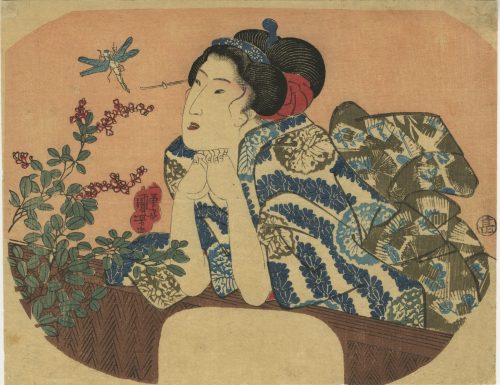 Artist: Utagawa Kuniyoshi [歌川 國芳] (1798 – 1861). A beauty leaning on a fence and watching a dragonfly hovering above a flowering plant. Signed: Ichiyûsai Kuniyoshi ga (一勇斎 國芳 画) in a double gourd-shaped red cartouche. Publisher: Maruya Jinpachi, seal Jin [甚] (Marks 08-088 | 294d). No date/censor seal. Media: Fan print (uchiwa-e, 団扇絵), 234 x 301 mm.
Artist: Utagawa Kuniyoshi [歌川 國芳] (1798 – 1861). A beauty leaning on a fence and watching a dragonfly hovering above a flowering plant. Signed: Ichiyûsai Kuniyoshi ga (一勇斎 國芳 画) in a double gourd-shaped red cartouche. Publisher: Maruya Jinpachi, seal Jin [甚] (Marks 08-088 | 294d). No date/censor seal. Media: Fan print (uchiwa-e, 団扇絵), 234 x 301 mm. -
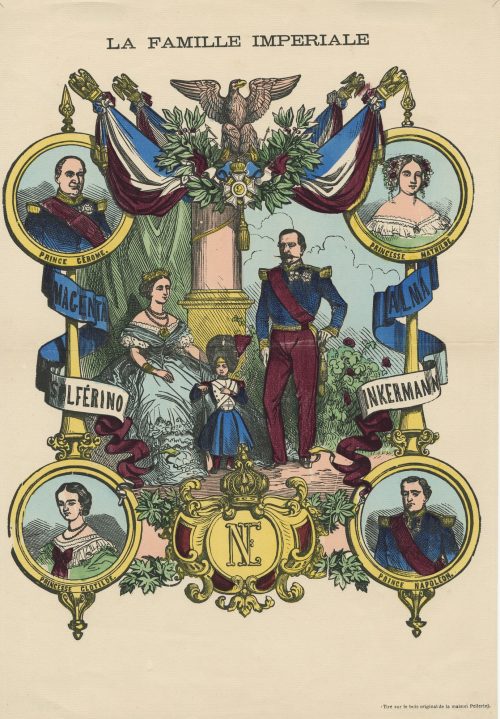 Hand-coloured woodcut on laid paper, 422 x 294 mm; black ink stamp “5307” to reverse, centrefold. Top center: "LA FAMILLE IMPERIALE"; Bottom right: "(Tire sur le bois original de maison Pellerin)". Image: Napoléon III, Empress Eugenie, and Prince Imperial Louis-Napoléon as a child surrounded with four lettered medallions: “PRINCE GÉROME”, “PRINCESSE MATHILDE”, “PRINCESSE CLOTILDE”, and “PRINCE NAPOLÉON”; ribbons lettered: “MAGENTA”, SOLFERINO”, “ALMA”, and “INKERMANN” around heraldic spears; coat of arms with imperial monogram between Princesse Clotilde and Prince Napoléon. Publisher/printer: Jean Charles Pellerin (French, 1756 – 1836). Battle of Magenta : 4 June 1859, against the Austrians. Battle of Solferino : 24 June 1859, against the Austrians. Battle of the Alma : 20 September 1854 (Crimean War) Battle of Inkerman : 5 November 1854 (Crimean War) Characters: Napoleon III [Charles-Louis Napoléon Bonaparte] (French, 1808 – 1873) Eugénie de Montijo [L'impératrice Eugénie] (Spanish-French, 1826 – 1920) Napoléon, Prince Imperial (Napoléon Eugène Louis Jean Joseph Bonaparte] (French, 1856 – 1879) Napoléon-Jérôme Bonaparte [Prince Jérôme] (French, 1822 – 1891) Mathilde Bonaparte [Princess Mathilde] (French, 1820 – 1904) Marie-Clotilde de Savoie [Princesse Clotilde] (French, 1843 – 1911)
Hand-coloured woodcut on laid paper, 422 x 294 mm; black ink stamp “5307” to reverse, centrefold. Top center: "LA FAMILLE IMPERIALE"; Bottom right: "(Tire sur le bois original de maison Pellerin)". Image: Napoléon III, Empress Eugenie, and Prince Imperial Louis-Napoléon as a child surrounded with four lettered medallions: “PRINCE GÉROME”, “PRINCESSE MATHILDE”, “PRINCESSE CLOTILDE”, and “PRINCE NAPOLÉON”; ribbons lettered: “MAGENTA”, SOLFERINO”, “ALMA”, and “INKERMANN” around heraldic spears; coat of arms with imperial monogram between Princesse Clotilde and Prince Napoléon. Publisher/printer: Jean Charles Pellerin (French, 1756 – 1836). Battle of Magenta : 4 June 1859, against the Austrians. Battle of Solferino : 24 June 1859, against the Austrians. Battle of the Alma : 20 September 1854 (Crimean War) Battle of Inkerman : 5 November 1854 (Crimean War) Characters: Napoleon III [Charles-Louis Napoléon Bonaparte] (French, 1808 – 1873) Eugénie de Montijo [L'impératrice Eugénie] (Spanish-French, 1826 – 1920) Napoléon, Prince Imperial (Napoléon Eugène Louis Jean Joseph Bonaparte] (French, 1856 – 1879) Napoléon-Jérôme Bonaparte [Prince Jérôme] (French, 1822 – 1891) Mathilde Bonaparte [Princess Mathilde] (French, 1820 – 1904) Marie-Clotilde de Savoie [Princesse Clotilde] (French, 1843 – 1911) -
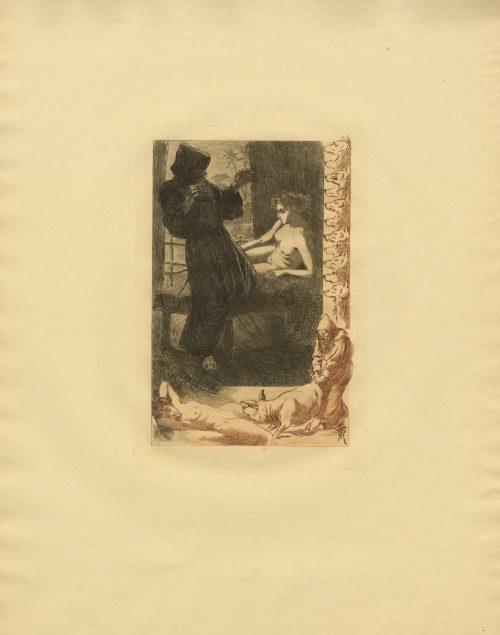 Set of 21 etchings by Martin van Maele for the English edition of ‘Thais’ by Anatole France published in London by Charles Carrington in 1901. Printed on vowe paper without a watermark in two colours with the black image and sepia historiated border. All etchings are inscribed with the artist's monogram; one of the etchings bears inscriptions ORGUEIL, LUXURE, DOUTE (mirror image). Dimensions: sheet: 317 x 250 mm; plate: 170 x 115 mm; image: 155 x 100 mm. Catalogue raisonné: S. A. Perry: № 64. Per Perry, the edition was printed in 500 copies on 'handmade paper watermarked 'Van Gelder'. Contributor: Martin van Maële [Martin, Maurice François Alfred] (French, 1863 – 1926)
Set of 21 etchings by Martin van Maele for the English edition of ‘Thais’ by Anatole France published in London by Charles Carrington in 1901. Printed on vowe paper without a watermark in two colours with the black image and sepia historiated border. All etchings are inscribed with the artist's monogram; one of the etchings bears inscriptions ORGUEIL, LUXURE, DOUTE (mirror image). Dimensions: sheet: 317 x 250 mm; plate: 170 x 115 mm; image: 155 x 100 mm. Catalogue raisonné: S. A. Perry: № 64. Per Perry, the edition was printed in 500 copies on 'handmade paper watermarked 'Van Gelder'. Contributor: Martin van Maële [Martin, Maurice François Alfred] (French, 1863 – 1926) -
 Artist: Utagawa Toyokuni I [歌川豊国] (1769–1825). Title: 「しなのやおこん 瀬川菊之丞」「帯屋長右衛門 嵐雛助」 Kabuki play: Katsuragawa Renri no Shigarami [桂川連理柵]. According to Waseda University Cultural Resource Database, the play was performed at Ichimura-za (Edo) on the 2nd month of Kansei 12 (year 1800) under the title 楼門五山桐 さんもんごさんのきり. Publisher: Nishimuraya Yohachi [西村屋与八] (Japanese, c. 1751 – 1869)., Play by Suga Sensuke [菅専助] (ca. 1728 – 1791) in two acts. First performed at Kita Horie-za in Osaka in October 1776. Based on a real incident occurring sometime in the Kyōhō era (1716-35), this story was first dramatized in 1761. The first Kabuki drama to stem from this play was in 1777 at Osaka's Araki-za. Obiya Chōemon, a married obi merchant (sitting with abacus) in his forties, meets his neighbour's daughter Ohan (standing behind Obiya), who is young enough to be his daughter, at an inn in Ishibe; the two fall in love and pledged their troth. Ohan becomes pregnant. After a series of misfortunes, the lovers rush to Katsuragawa (Katsura River), where they drown themselves.
Artist: Utagawa Toyokuni I [歌川豊国] (1769–1825). Title: 「しなのやおこん 瀬川菊之丞」「帯屋長右衛門 嵐雛助」 Kabuki play: Katsuragawa Renri no Shigarami [桂川連理柵]. According to Waseda University Cultural Resource Database, the play was performed at Ichimura-za (Edo) on the 2nd month of Kansei 12 (year 1800) under the title 楼門五山桐 さんもんごさんのきり. Publisher: Nishimuraya Yohachi [西村屋与八] (Japanese, c. 1751 – 1869)., Play by Suga Sensuke [菅専助] (ca. 1728 – 1791) in two acts. First performed at Kita Horie-za in Osaka in October 1776. Based on a real incident occurring sometime in the Kyōhō era (1716-35), this story was first dramatized in 1761. The first Kabuki drama to stem from this play was in 1777 at Osaka's Araki-za. Obiya Chōemon, a married obi merchant (sitting with abacus) in his forties, meets his neighbour's daughter Ohan (standing behind Obiya), who is young enough to be his daughter, at an inn in Ishibe; the two fall in love and pledged their troth. Ohan becomes pregnant. After a series of misfortunes, the lovers rush to Katsuragawa (Katsura River), where they drown themselves.Segawa Kikunojō III (Japanese, 1751 – 1810); other names: Segawa Senjo, Segawa Rokō III, Segawa Tomisaburō I, Ichiyama Tomisaburō, Ichiyama Shichinosuke. The actor held the name of Segawa Kikunojō III from the 11th lunar month of 1774 to the 7th lunar month of 1801. He surpassed all the actors of his time in both female and male roles, especially in the former, and achieved tremendous public acclaim.
Arashi Hinasuke II [嵐雛助] (Japanese, c. 1774 – 1801); other names: Nakamura Jūzō III, Kanō Hidenosuke I, Arashi Hidenosuke I. The actor held the name of Arashi Hinasuke II from the 1st lunar month of 1794 to the 2nd lunar month of 1801. Hi died in Edo on the 4th day of the 2nd lunar month of 1801. For the same characters illustrated by Utagawa Kuniyoshi see SVJP-0333.2021. Sources:
Sources:
- Historical Dictionary of Japanese Traditional Theatre By Samuel L. Leiter. Second edition, 2014.
- Kabuki Encyclopedia. An English-Langauge Adaptation of Kabuki Jiten. Samuel L. Leiter. Greenwood Press, 1979.
- http://www.kabuki21.com/
- Waseda University Cultural Resource Database
-
 Kikukawa Eizan (菊川 英山, 1787 – July 17, 1867) Signed: Eizan hitsu (英山筆)
Kikukawa Eizan (菊川 英山, 1787 – July 17, 1867) Signed: Eizan hitsu (英山筆)Jacob Pins #972/p.341. Leiden, Rijksmuseum voor Volkenkunde.
"The Lovers Miura-ya Komurasaki and Shirai Gonpachi: Tragic love stories taken from real life and dramatized were a staple of stage and print; the darkly romantic combination of desire and death was hugely popular in the eighteenth century. Hirai Gompachi was a warrior of the Tottori fief in western Japan who fled to Edo after committing a murder. He was apprehended and sentenced to death in 1679. His distraught lover, the courtesan Komurasaki, committed suicide at his grave." [MET]
.
-
 Title: Eleventh lunar month (Chuto no zu); Series: Fashionable Twelve Months (Imayo juni-kagetsu). Another version of translation: Modern Beauties of Twelve Months. Artist: Utagawa Toyokuni I [歌川豊国] (1769–1825). Pubisher: Ibaya Senzaburō [伊場屋仙三郎] (Japanese, 1815 – 1869), seal: Dansendō [伊場仙]. Signed: Toyokuni ga and sealed with toshidama. Date-kiwame seal: Ushi (ox), Bunsei 5 (1822). Size: double-sheet uncut fan print ( aiban uchiwa-e), 219 x 295 mm.
Title: Eleventh lunar month (Chuto no zu); Series: Fashionable Twelve Months (Imayo juni-kagetsu). Another version of translation: Modern Beauties of Twelve Months. Artist: Utagawa Toyokuni I [歌川豊国] (1769–1825). Pubisher: Ibaya Senzaburō [伊場屋仙三郎] (Japanese, 1815 – 1869), seal: Dansendō [伊場仙]. Signed: Toyokuni ga and sealed with toshidama. Date-kiwame seal: Ushi (ox), Bunsei 5 (1822). Size: double-sheet uncut fan print ( aiban uchiwa-e), 219 x 295 mm.

-
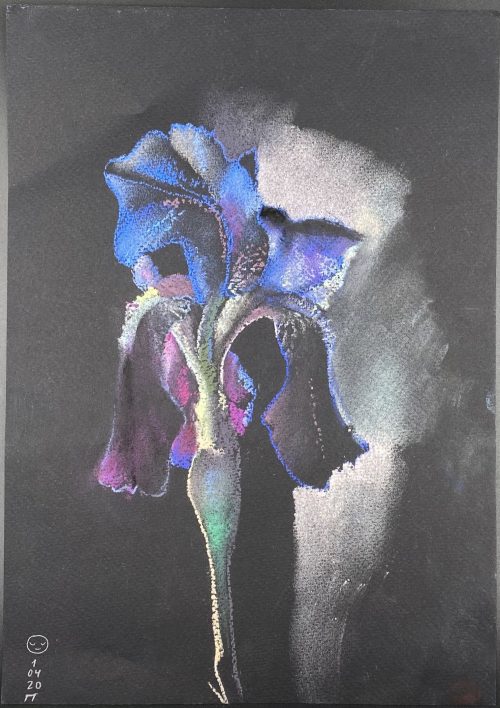 Polina de Mauny [Vladimirova] (Russian, French, b. 1981). Dry pastel on black paper. Size: 30 x 21 cm.
Polina de Mauny [Vladimirova] (Russian, French, b. 1981). Dry pastel on black paper. Size: 30 x 21 cm. -
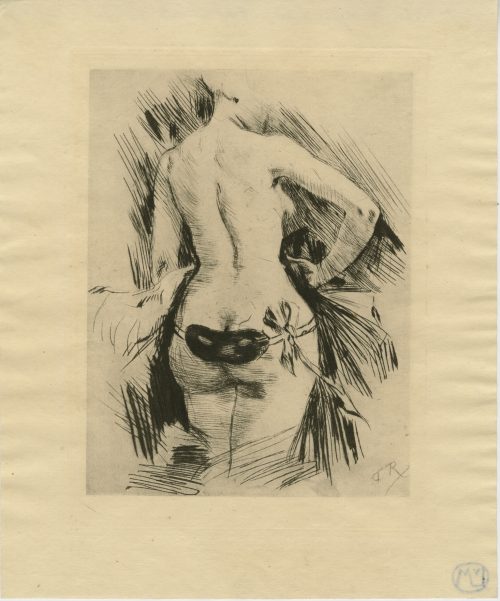
Etching and drypoint on wove paper, depicting a woman with a face mask on her buttocks. Monogrammed in the plate 'FR'. Owner's stamp 'LvM' on verso.
Dimensions: Papaer: 22.2 x 18.5 cm; Plate: 17.5 x 13.3 cm; Image: 15.5 x 12 cm.
Catalogue raisonné: Arthur Hubschmid (1977): 448; Graphics irreverent and erotic (1968): 106; Rouir 648.
-
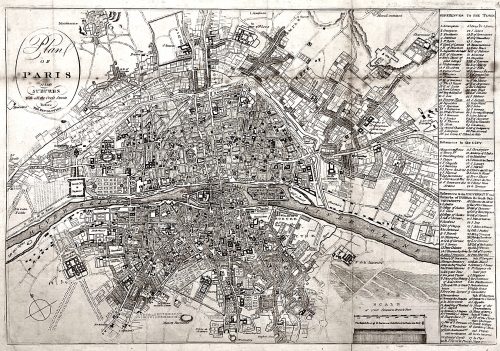 Oval cartouche in the upper-left corner, with tall “s”: Plan | OF | PARIS | and | SUBURBS | With all the Cross Streets | Before | THE REVOLUTION. || No indication of the makers. Dimensions: Sheet: 32.5 x 44.3 cm; Image: 28.5 x 41.3 cm.
Oval cartouche in the upper-left corner, with tall “s”: Plan | OF | PARIS | and | SUBURBS | With all the Cross Streets | Before | THE REVOLUTION. || No indication of the makers. Dimensions: Sheet: 32.5 x 44.3 cm; Image: 28.5 x 41.3 cm. -
 Artist: Utagawa Kuniyoshi [歌川 國芳] (Japanese, 1798 – 1861) Publisher: British Museum provides for the title as Enkyoku-zoroi [艶曲揃] (Set of Voluptuous Melodies) and the publisher as Sanpei. Indeed, 三平 (Sanpei) was a wholesale fan shop at the end of the Edo period. However, Andreas Marks identifies the publisher’s seal as 三平 Mihei = Mikawaya Heiroku (1848-56), a member of the Fan Producing Guild (AM 11-016|325a). Block carver: Hori Take [彫竹]
Artist: Utagawa Kuniyoshi [歌川 國芳] (Japanese, 1798 – 1861) Publisher: British Museum provides for the title as Enkyoku-zoroi [艶曲揃] (Set of Voluptuous Melodies) and the publisher as Sanpei. Indeed, 三平 (Sanpei) was a wholesale fan shop at the end of the Edo period. However, Andreas Marks identifies the publisher’s seal as 三平 Mihei = Mikawaya Heiroku (1848-56), a member of the Fan Producing Guild (AM 11-016|325a). Block carver: Hori Take [彫竹]Signed: Ichiyosai Kuniyoshi ga in a red cartouche and sealed with paulownia (kiri mon).
Date seal and double nanushi censor seals: Fuku & Muramatsu, 1853 (Kaei 6, 2nd month).
Size: Uchiwa-e (untrimmed fan print) 229 x 294 mm.
Provenance: The Collection of Paul F. Walter, Christie's, New York, 2017, lot 338; sold together with 10 other fan prints for $27,500. Before: Christie's, New York, 1994, lot 145 ($4,830). Ref: [LIB-1693.2018] The Collection of Paul Walter. — NY: Christie's, 2017, p. 361. Ref: Israel Goldman, Catalogue 2018, № 41: "Utagawa Kuniyoshi (1797-1861) A Woman on a Terrace Dancing with a Fan. From the series Enkyoku zoroi (Collection of Charming Music). 1853. Fan print. 22.9 x 29.4 cm. Provenance: Japanese Prints, Paintings and Screens, Christie's, New York, 1994, lot 145 ($4,830); The Collection of Paul F. Walter, Christie's, New York, 2017, lot 338. Fine impress." Known prints in this series:
SVJP-0251.2018
-
 Artist: Utagawa Kunisada [歌川 国貞] a.k.a. Utagawa Toyokuni III [三代歌川豊国] (Japanese, 1786 – 1865). Pubisher (accorfding to Suzuki & Oka): Ibaya Senzaburō [伊場屋仙三郎] (Japanese, 1815 – 1869), Dansendō [伊場仙]. Title: Beauty holding a roll of paper (by seller); A woman of Edo (by Suzuki & Oka) Date seal and aratame censor seal: 1822 (Bunsei 5). Signed: Gototei Kunisada ga [五渡亭国貞画]. Media: Untrimmed fan print (uchiwa-e), 228 x 295 mm. Ref: [LIB-3085.2022] Jūzō Suzuki, Isaburō Oka. “The decadents”. — Tokyo: Kodansha International, 1969, p. 35, plate 30: exactly this print:
Artist: Utagawa Kunisada [歌川 国貞] a.k.a. Utagawa Toyokuni III [三代歌川豊国] (Japanese, 1786 – 1865). Pubisher (accorfding to Suzuki & Oka): Ibaya Senzaburō [伊場屋仙三郎] (Japanese, 1815 – 1869), Dansendō [伊場仙]. Title: Beauty holding a roll of paper (by seller); A woman of Edo (by Suzuki & Oka) Date seal and aratame censor seal: 1822 (Bunsei 5). Signed: Gototei Kunisada ga [五渡亭国貞画]. Media: Untrimmed fan print (uchiwa-e), 228 x 295 mm. Ref: [LIB-3085.2022] Jūzō Suzuki, Isaburō Oka. “The decadents”. — Tokyo: Kodansha International, 1969, p. 35, plate 30: exactly this print:
-
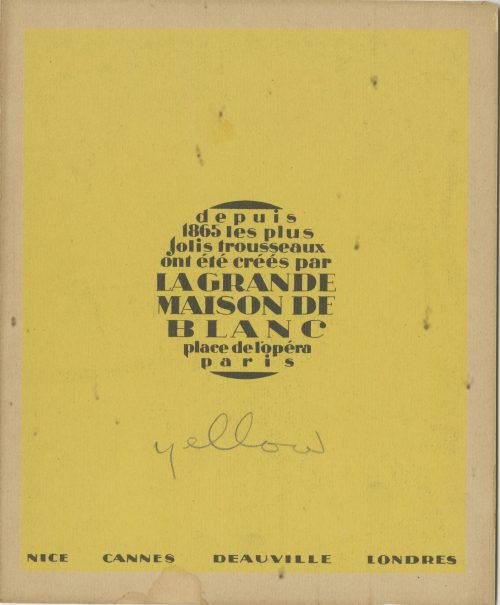 Four chromolithographic plates, each sheet 180 x 150 mm; image 16 x 12.5 cm after Feodor Rojankovsky, signed “Rojan”, titles printed on the back on red (à la chasse), blue (en voyage), green (aux courses), and yellow (depuis | 1865 les plus | jolis trousseaux | ont été créés par | LA GRANDE | MAISON DE | BLANC | place de l’opera | Paris | NICE CANNES DEAUVILLE LONDRES) background. Contributors: Feodor Rojankovsky [Rojan, Фёдор Степанович Рожанковский] (Russian-American, 1891 – 1970) – artist.
Four chromolithographic plates, each sheet 180 x 150 mm; image 16 x 12.5 cm after Feodor Rojankovsky, signed “Rojan”, titles printed on the back on red (à la chasse), blue (en voyage), green (aux courses), and yellow (depuis | 1865 les plus | jolis trousseaux | ont été créés par | LA GRANDE | MAISON DE | BLANC | place de l’opera | Paris | NICE CANNES DEAUVILLE LONDRES) background. Contributors: Feodor Rojankovsky [Rojan, Фёдор Степанович Рожанковский] (Russian-American, 1891 – 1970) – artist. -
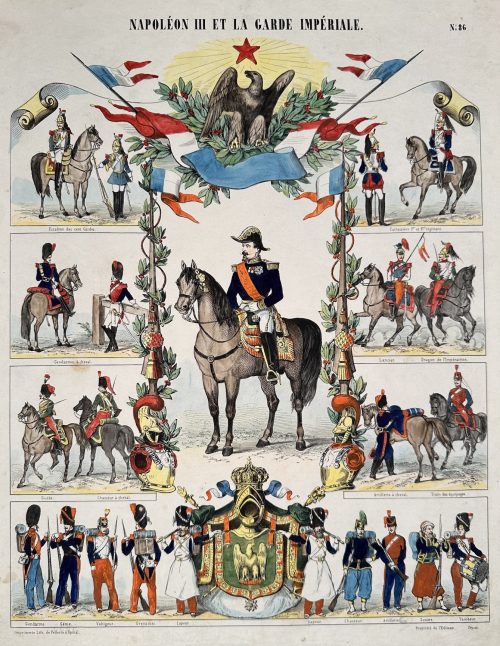 Hand-coloured woodcut on wove paper, 460 x 356 mm; black ink stamp “5055” to reverse. Top centre: "NAPOLÉON III ET LA GARDE IMPÉRIALE"; right: "№ 86". Napoléon III ahorseback in middle, beside (top to bottom): Escadron des cent Gardes — Cuirassiers 1er et 2me regiment; Gendarmes à cheval. — Lancier., Dragon de l’Impératrice.; Guide., Chasseur à cheval. — Artillerie à cheval, Train des équipages.; Gendarme. Génie. Voltigeur. Grenadier. Sapeur. Sapeur. Chasseur. Artillerie. Zouave. Tambour. Bottom left: Imprimerie Lith. de Pellerin à Épinal; right: Propriété de l’Éditeur. Déposé. Jean Charles Pellerin (French, 1756 – 1836) – printer/publisher.
Hand-coloured woodcut on wove paper, 460 x 356 mm; black ink stamp “5055” to reverse. Top centre: "NAPOLÉON III ET LA GARDE IMPÉRIALE"; right: "№ 86". Napoléon III ahorseback in middle, beside (top to bottom): Escadron des cent Gardes — Cuirassiers 1er et 2me regiment; Gendarmes à cheval. — Lancier., Dragon de l’Impératrice.; Guide., Chasseur à cheval. — Artillerie à cheval, Train des équipages.; Gendarme. Génie. Voltigeur. Grenadier. Sapeur. Sapeur. Chasseur. Artillerie. Zouave. Tambour. Bottom left: Imprimerie Lith. de Pellerin à Épinal; right: Propriété de l’Éditeur. Déposé. Jean Charles Pellerin (French, 1756 – 1836) – printer/publisher. -
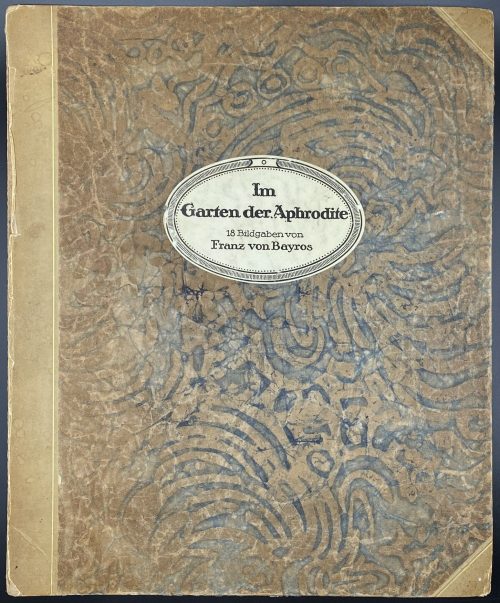 Cover with title: Im Garten der Aphrodite | 18 Bildgaben | von | Franz von Bayros | {vignette} | Privatdruck || in a frame; table of contents and limitation to verso; 18 plates with the drawings of Bayros in collotype reproduction, each mounted on cardboard and protected with the remnants of tissue guards, some lacking. Of the publisher’s folder, only the front board with an oval title label is present. Some images signed “Choisy le Conin” – von Bayros’s pseudonym. Two prints are missing: (1) Das Füßchen and (2) Die Liebesschaukel, the other 16 prints present. The vignette on the cover is a photomechanical reproduction. Edition: limited to 350 copies of which this is № 253. According to Christie’s: a collotype reprint, about twenty years after their first publication. English equivalent: The Garden of Aphrodite. Portfolio with 18 photogravures. Catalogue raisonné: The amorous drawings of the Marquis von Bayros (1968): pp. 177-1877; Bayros Zeichningen (1987): pp. 143-152.
Cover with title: Im Garten der Aphrodite | 18 Bildgaben | von | Franz von Bayros | {vignette} | Privatdruck || in a frame; table of contents and limitation to verso; 18 plates with the drawings of Bayros in collotype reproduction, each mounted on cardboard and protected with the remnants of tissue guards, some lacking. Of the publisher’s folder, only the front board with an oval title label is present. Some images signed “Choisy le Conin” – von Bayros’s pseudonym. Two prints are missing: (1) Das Füßchen and (2) Die Liebesschaukel, the other 16 prints present. The vignette on the cover is a photomechanical reproduction. Edition: limited to 350 copies of which this is № 253. According to Christie’s: a collotype reprint, about twenty years after their first publication. English equivalent: The Garden of Aphrodite. Portfolio with 18 photogravures. Catalogue raisonné: The amorous drawings of the Marquis von Bayros (1968): pp. 177-1877; Bayros Zeichningen (1987): pp. 143-152. -
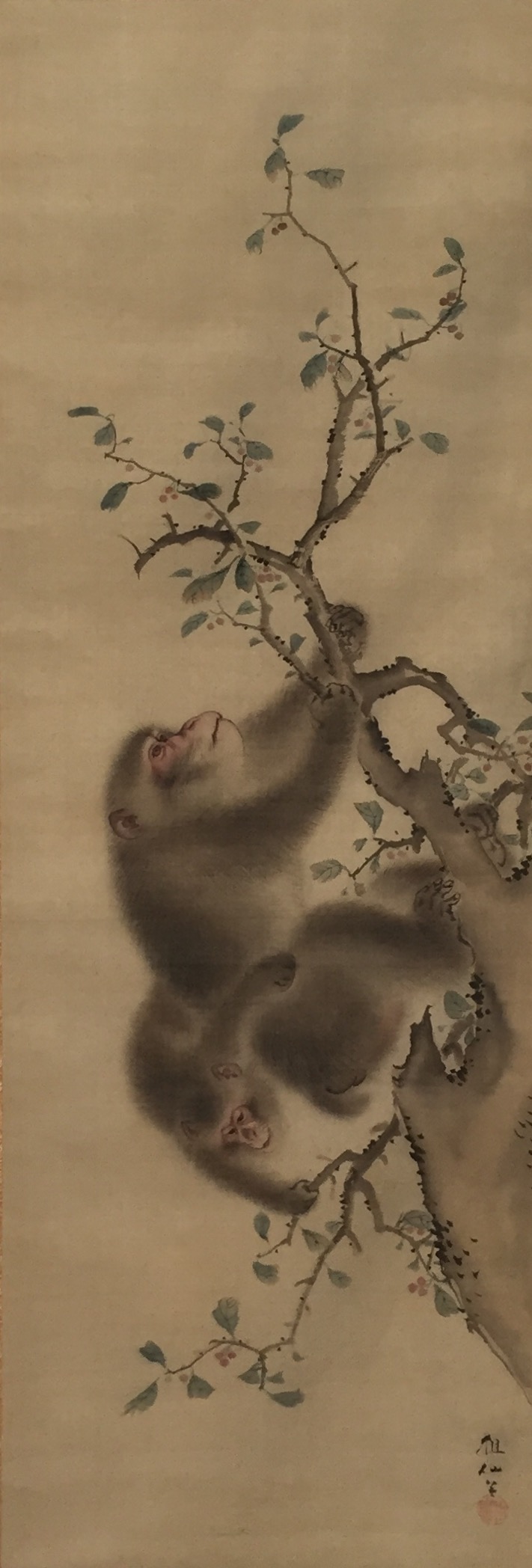 Mori Sosen (1747-1821). Two Monkeys Hanging From Branches. Hanging Scroll Painting. Ink and colour on silk. Signed: Sosen. Sealed: Sosen.
Mori Sosen (1747-1821). Two Monkeys Hanging From Branches. Hanging Scroll Painting. Ink and colour on silk. Signed: Sosen. Sealed: Sosen. -
 Artist: Utagawa Toyokuni I (1769–1825) Title: Actors Bando Mitsugorō, Ichikawa Danjūrō, Onoe Kikugorō in play The Maiden at Dōjō Temple. Presumably Bunka 13 (1816) at Nakamura Theater in Edo. Publisher: Mikawaya Seiemon (c. 1805-1829); Marks' "Publishers" № 328, p. 235. Size: Vertical ôban MEDIUM OR TECHNIQUE: Woodblock print (nishiki-e); ink and color on paper. Signed: Toyokuni ga Censor's seal: kiwame Detailed discussion on the topic can be seen at: The Maiden at Dōjō Temple
Artist: Utagawa Toyokuni I (1769–1825) Title: Actors Bando Mitsugorō, Ichikawa Danjūrō, Onoe Kikugorō in play The Maiden at Dōjō Temple. Presumably Bunka 13 (1816) at Nakamura Theater in Edo. Publisher: Mikawaya Seiemon (c. 1805-1829); Marks' "Publishers" № 328, p. 235. Size: Vertical ôban MEDIUM OR TECHNIQUE: Woodblock print (nishiki-e); ink and color on paper. Signed: Toyokuni ga Censor's seal: kiwame Detailed discussion on the topic can be seen at: The Maiden at Dōjō Temple -
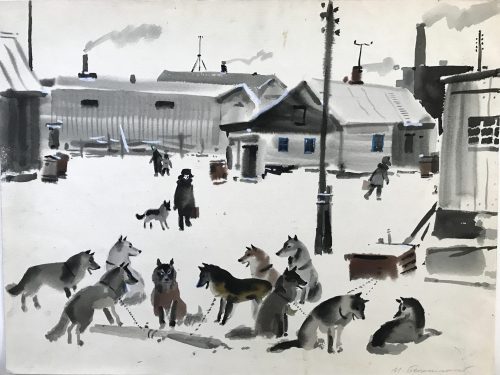 Mikhail Belomlinsky. Born 1934, Russia. Village, dogs. Watercolor painting on paper from Chukotka expedition, 1975. Size: 36 x 48 cm.
Mikhail Belomlinsky. Born 1934, Russia. Village, dogs. Watercolor painting on paper from Chukotka expedition, 1975. Size: 36 x 48 cm. -
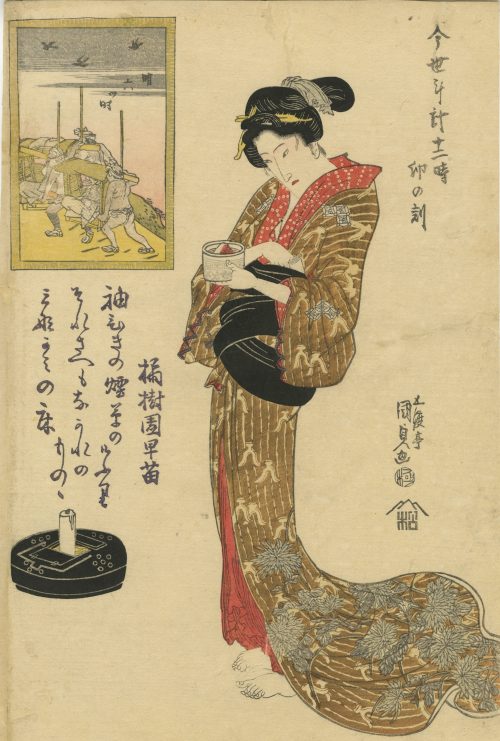 Artist: Utagawa Kunisada [歌川 国貞] a.k.a. Utagawa Toyokuni III [三代歌川豊国] (Japanese, 1786 – 1865). Publisher: Matsumura Tatsuemon [松村辰右衛門] (Japanese, fl. c. 1793 – 1832). Year: c. 1820–22 (Bunsei era). Signed: 五渡亭国貞画 – Gototei Kunisada ga. Censor's seal: kiwame 改印:極
Artist: Utagawa Kunisada [歌川 国貞] a.k.a. Utagawa Toyokuni III [三代歌川豊国] (Japanese, 1786 – 1865). Publisher: Matsumura Tatsuemon [松村辰右衛門] (Japanese, fl. c. 1793 – 1832). Year: c. 1820–22 (Bunsei era). Signed: 五渡亭国貞画 – Gototei Kunisada ga. Censor's seal: kiwame 改印:極

SVJP-0179-6.2014
The Hour of the Dragon, Fifth Hour of Day (Tatsu no koku, Hi no itsutsu toki), from the series Twelve Hours of a Modern Clock (Imayo tokei jūniji) 「今世時計十二時 辰ノ刻 日ノ五つ時」 MFA impression: 11.15315. 
SVJP-0179-1.2014
The Hour of the Rabbit, Sixth Hour of Day (U no koku, Ake muttsu toki), from the series Twelve Hours of a Modern Clock (Imayo tokei jūniji) 「今世時計十二時 卯ノ刻 明六つ時」. MFA impression: 11.15317 
SVJP-0179-2.2014
The Hour of the Monkey, Seventh Hour of Day (Saru no koku, Hi no nanatsu toki), from the series Twelve Hours of a Modern Clock (Imayo tokei jūniji) 「今様時計十二時 申ノ刻 日ノ七つ時」 MFA impression: 11.39692 
SVJP-0179-8.2014
The Hour of the Horse, Ninth Hour of Day (Uma no koku, Hi kokonotsu toki), from the series Twelve Hours of a Modern Clock (Imayo tokei jūniji) 「今世時計十二時 午ノ刻 日九つ時」. MFA impression: 11.15314 
SVJP-0179-4.2014
The Hour of the Boar, Fourth Hour of Night (I no koku, Yoru yottsu toki), from the series Twelve Hours of a Modern Clock (Imayo tokei jūniji) 「今世時計十二時 亥ノ刻 夜四つ時」. MFA impression: 11.15552 
SVJP-0179-3.2014
The Hour of the Tiger, Seventh Hour of Night (Tora no koku, Yoru nanatsu), from the series Twelve Hours of a Modern Clock (Imayo tokei jūniji) 「今世時計十二時 寅ノ刻 夜七つ」. MFA impression: 11.15313 Ref.: Izzard. Kunisada’s world [LIB-2970.2022]. 
SVJP-0179-5.2014
The Hour of the Ox, Eight Hour of Night (Ushi no koku, Yoru no yattsu toki), from the series Twelve Hours of a Modern Clock (Imayo tokei jūniji) 「今世時計十二時 丑ノ刻 夜ノ八つ時」. MFA impression: 11.26906 
SVJP-0179-7.2014
The Hour of the Rat, Ninth Hour of Night (Ne no koku, Yoru kokonotsu toki), from the series Twelve Hours of a Modern Clock (Imayo tokei jūniji) 「今世時計十二時 子ノ刻 夜九つ時」. MFA impression: 11.15312 -
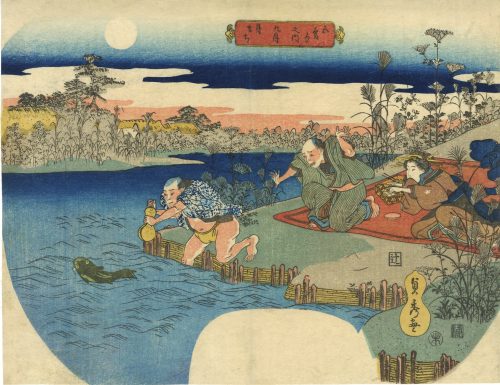 Artist: Utagawa Sadahide [歌川貞秀] (Japanese, 1807 – 1879). Publisher: Iseya Ichiemon [伊勢屋市右衛門] (Japanese, fl. c. 1820s – c. 1860s). Size: Uncut fan print (uchiwa-e), 220 x 285 mm. Date-kiwame seal: 1835 (Tenpō 6). Signed: Sadahide ga in a double-gourd cartouche. Man trying to catch a catfish with a gourd during a picnic on an autumn evening. Five Festivals [五節句の內] (Gosekku no uchi), Ninth Month [九月] (Kugatu), Full moon celebration on the 15th night of the month (Tsuki machi) [月まち] or [月待]. The autumnal spirit is also supported by the presence of Patrinia scabiosifolia (ominaeshi) [女郎花] and Miscanthus sinensis, or Japanese pampas grass (susuki) [薄]. These two are part of the Seven Grasses of Autumn (aki no nanakusa) [秋の七草]. Description by Richard Kruml: "Viewing the full moon in the eighth and ninth months was a popular activity passed down from the aristocracy in Heian times; especially where the moon's reflection could be seen in the water. One such party is seen here where a member vainly attempts to catch a catfish with a gourd: A hopeless task with such an unsuitable utensil. This is based on a Zen riddle posed by the shōgun Ashikaga Yoshimochi [足利 義持] (Japanese, 1386 – 1428) on how to catch a catfish with a gourd, which inspired the 15th-century artist Josetsu [如拙] (Japanese, fl. 1405 – 1496) to paint the subject with accompanying poems on the conundrum by Zen monks".
Artist: Utagawa Sadahide [歌川貞秀] (Japanese, 1807 – 1879). Publisher: Iseya Ichiemon [伊勢屋市右衛門] (Japanese, fl. c. 1820s – c. 1860s). Size: Uncut fan print (uchiwa-e), 220 x 285 mm. Date-kiwame seal: 1835 (Tenpō 6). Signed: Sadahide ga in a double-gourd cartouche. Man trying to catch a catfish with a gourd during a picnic on an autumn evening. Five Festivals [五節句の內] (Gosekku no uchi), Ninth Month [九月] (Kugatu), Full moon celebration on the 15th night of the month (Tsuki machi) [月まち] or [月待]. The autumnal spirit is also supported by the presence of Patrinia scabiosifolia (ominaeshi) [女郎花] and Miscanthus sinensis, or Japanese pampas grass (susuki) [薄]. These two are part of the Seven Grasses of Autumn (aki no nanakusa) [秋の七草]. Description by Richard Kruml: "Viewing the full moon in the eighth and ninth months was a popular activity passed down from the aristocracy in Heian times; especially where the moon's reflection could be seen in the water. One such party is seen here where a member vainly attempts to catch a catfish with a gourd: A hopeless task with such an unsuitable utensil. This is based on a Zen riddle posed by the shōgun Ashikaga Yoshimochi [足利 義持] (Japanese, 1386 – 1428) on how to catch a catfish with a gourd, which inspired the 15th-century artist Josetsu [如拙] (Japanese, fl. 1405 – 1496) to paint the subject with accompanying poems on the conundrum by Zen monks". -
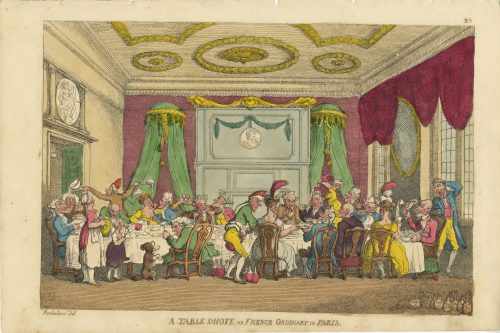 Hand-coloured etching by Thomas Rowlandson, printed on May 30, 1810, in London; № 20 from the series The Caricature Magazine or Hudibrastic Mirror Vol. 2. Description by Metropolitan Museum (59.533.978): "Guests of a dinner sit at a long narrow table in a magnificent room with an ornate ceiling. Two men and a young woman serve wine, one drawing a cork, the others spilling wine over the guests. Another waiter spills soup in an elderly guest's face. A woman and a little girl with a begging dog play tambourine and triangle at left." Inscribed in plate lower left: "Rowlandson Del."; bottom centre: "A TABLE DHOTE, OR FRENCH ORDINARY IN PARIS." Our copy is lacking the publication details: "Pub.d May 30. 1810 by Tho.s Tegg 111 Cheapside, London." and similar to the copy in Boston Public Library (18_03_000394). Dimensions: Sheet 27 x 40.5 cm; Image: 23.5 x 35 cm. Contributors: Thomas Rowlandson (British, 1756 – 1827) – artist. Thomas Tegg (British, 1776 – 1846) – publisher.
Hand-coloured etching by Thomas Rowlandson, printed on May 30, 1810, in London; № 20 from the series The Caricature Magazine or Hudibrastic Mirror Vol. 2. Description by Metropolitan Museum (59.533.978): "Guests of a dinner sit at a long narrow table in a magnificent room with an ornate ceiling. Two men and a young woman serve wine, one drawing a cork, the others spilling wine over the guests. Another waiter spills soup in an elderly guest's face. A woman and a little girl with a begging dog play tambourine and triangle at left." Inscribed in plate lower left: "Rowlandson Del."; bottom centre: "A TABLE DHOTE, OR FRENCH ORDINARY IN PARIS." Our copy is lacking the publication details: "Pub.d May 30. 1810 by Tho.s Tegg 111 Cheapside, London." and similar to the copy in Boston Public Library (18_03_000394). Dimensions: Sheet 27 x 40.5 cm; Image: 23.5 x 35 cm. Contributors: Thomas Rowlandson (British, 1756 – 1827) – artist. Thomas Tegg (British, 1776 – 1846) – publisher. -
 Artist: Utagawa Kunisada [歌川 国貞] a.k.a. Utagawa Toyokuni III [三代歌川豊国] (Japanese, 1786 – 1865). Signed: Kunisada ga [国貞画] in a red double-gourd cartouche Publisher: Unknown (no seal). Date: c. 1832 Izzard: "... red cloth decorated with the characters Yauan, one of Ichikawa Danjūrō VII [市川団十郎] (Japanese, 1791 – 1859) poetry names, and the name of his residence in Fukagawa. The absence of publisher's emblem and censorship seals may indicate that this was a privately issued print, not for public use". Ref.: [LIB-2967.2022] Utagawa Kunisada (1786 – 1865): His world revisited / Catalogue № 17, Exhibition March 17-21, 2021. — NY: Sebastian Izzard, LLC., 2021; p. 112-3, fig. 32). Size: Fan print (aiban uchiwa-e); 235 x 295 mm.
Artist: Utagawa Kunisada [歌川 国貞] a.k.a. Utagawa Toyokuni III [三代歌川豊国] (Japanese, 1786 – 1865). Signed: Kunisada ga [国貞画] in a red double-gourd cartouche Publisher: Unknown (no seal). Date: c. 1832 Izzard: "... red cloth decorated with the characters Yauan, one of Ichikawa Danjūrō VII [市川団十郎] (Japanese, 1791 – 1859) poetry names, and the name of his residence in Fukagawa. The absence of publisher's emblem and censorship seals may indicate that this was a privately issued print, not for public use". Ref.: [LIB-2967.2022] Utagawa Kunisada (1786 – 1865): His world revisited / Catalogue № 17, Exhibition March 17-21, 2021. — NY: Sebastian Izzard, LLC., 2021; p. 112-3, fig. 32). Size: Fan print (aiban uchiwa-e); 235 x 295 mm. -
 Utagawa Kunisada [歌川 国貞]; a.k.a. Utagawa Toyokuni III [三代歌川豊国] (Japanese, 1786 – 1865). Signed: Toyokuni ga [豊国 画] in a yellow toshidama cartouche. Publisher: Unknown, seal [久] Kyū (Japanese, fl. c. 1851 – 1861); (Marks 07-023 | U176a, possibly Sagamia Kyūzō). Date seal and double nanushi censor seals: Fuku & Muramatsu, Kaei 6, 2nd month (2/1853). Inscription in a red cartouche: (Purple of Edo // Purple of the Bay Capital) [江都むらさき] (Edo Murasaki), alluding to Murasaki Shikibu [紫 式部] (Japanese, c. 973/8 – c. 1014/31), the author of Genji Monogatari [源氏物語] (The Tale of Genji), a Heian period novel which was the source of a parody Nise Murasaki Inaka Genji [偐紫田舎源氏] (Fake Murasaki’s Rustic Genji) by Ryutei Tanehiko [柳亭種彦] (Japanese, 1783 – 1842). According to Horst Graebner: The actor is Ichikawa Danjūrō VIII. Ichikawa Danjūrō VIII [市川団十郎] (Japanese, 1823 – 1854); other names: Ichikawa Ebizō VI, Ichikawa Shinnosuke II. One of the series of Kunisada’s fan prints in this collection:
Utagawa Kunisada [歌川 国貞]; a.k.a. Utagawa Toyokuni III [三代歌川豊国] (Japanese, 1786 – 1865). Signed: Toyokuni ga [豊国 画] in a yellow toshidama cartouche. Publisher: Unknown, seal [久] Kyū (Japanese, fl. c. 1851 – 1861); (Marks 07-023 | U176a, possibly Sagamia Kyūzō). Date seal and double nanushi censor seals: Fuku & Muramatsu, Kaei 6, 2nd month (2/1853). Inscription in a red cartouche: (Purple of Edo // Purple of the Bay Capital) [江都むらさき] (Edo Murasaki), alluding to Murasaki Shikibu [紫 式部] (Japanese, c. 973/8 – c. 1014/31), the author of Genji Monogatari [源氏物語] (The Tale of Genji), a Heian period novel which was the source of a parody Nise Murasaki Inaka Genji [偐紫田舎源氏] (Fake Murasaki’s Rustic Genji) by Ryutei Tanehiko [柳亭種彦] (Japanese, 1783 – 1842). According to Horst Graebner: The actor is Ichikawa Danjūrō VIII. Ichikawa Danjūrō VIII [市川団十郎] (Japanese, 1823 – 1854); other names: Ichikawa Ebizō VI, Ichikawa Shinnosuke II. One of the series of Kunisada’s fan prints in this collection: -
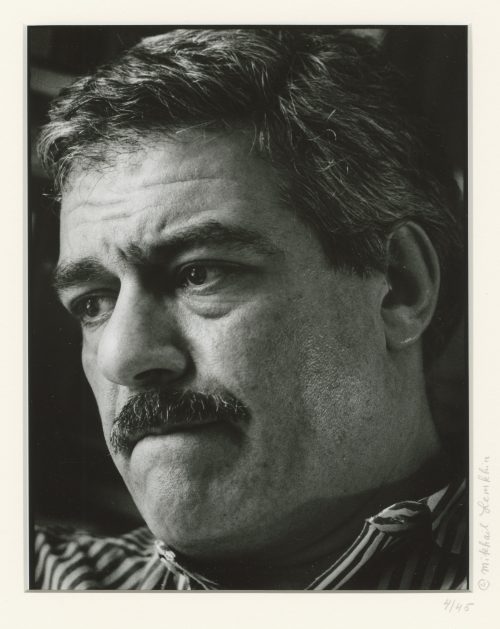 Photographic portrait of writer Andrei Sinyavsky, head and shoulder, turned to the left, wearing glasses. Pencil-signed on the mat: 4/45 • ©Mikhail Lemkhin; on the back of the print: Copyright statement stamp; ink stamp ©MIKHAIL LEMKHIN; ink stamp: PHOTO BY MIKHAIL LEMKHIN | 1811 38TH AVENUE | SAN FRANCISCO, CA 94122 | (415) 664-7677; pencil inscription on the back of the mat: (top) АНДРЕЙ СИНЯВСКИЙ | ANDREI SINYAVSKY, (bottom) XXIX. Size: mat: 43.2 x 35.5 cm; window: 23.5 x 18.5 cm; print: 25.2 x 20.2 cm. Limited edition of 45, of which this is № 4, signed and stamped by the artist. Sitter: Sergei Dovlatov [Сергей Донатович Довлатов] (Russian, 1941 – 1990)
Photographic portrait of writer Andrei Sinyavsky, head and shoulder, turned to the left, wearing glasses. Pencil-signed on the mat: 4/45 • ©Mikhail Lemkhin; on the back of the print: Copyright statement stamp; ink stamp ©MIKHAIL LEMKHIN; ink stamp: PHOTO BY MIKHAIL LEMKHIN | 1811 38TH AVENUE | SAN FRANCISCO, CA 94122 | (415) 664-7677; pencil inscription on the back of the mat: (top) АНДРЕЙ СИНЯВСКИЙ | ANDREI SINYAVSKY, (bottom) XXIX. Size: mat: 43.2 x 35.5 cm; window: 23.5 x 18.5 cm; print: 25.2 x 20.2 cm. Limited edition of 45, of which this is № 4, signed and stamped by the artist. Sitter: Sergei Dovlatov [Сергей Донатович Довлатов] (Russian, 1941 – 1990) -
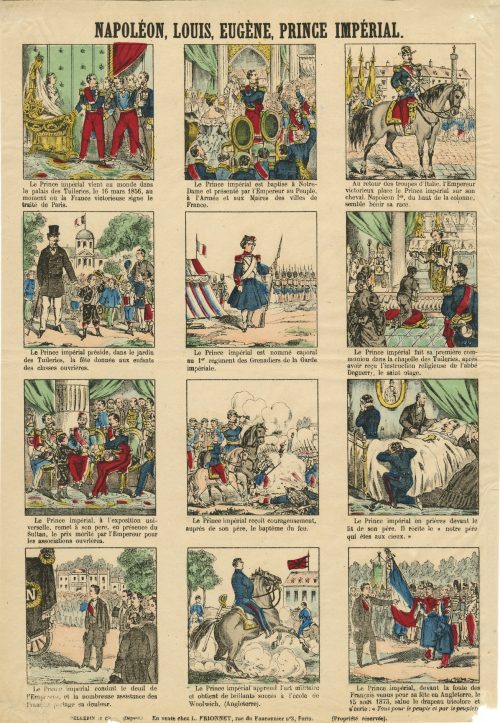 Hand-coloured woodcut on wove paper, 400 x 277 mm. Top: "NAPOLÉON, LOUIS, EUGÈNE, PRINCE IMPÉRIAL"; bellow 12 captioned frames:
Hand-coloured woodcut on wove paper, 400 x 277 mm. Top: "NAPOLÉON, LOUIS, EUGÈNE, PRINCE IMPÉRIAL"; bellow 12 captioned frames:- Le Prince impérial vient au monde dans le palais des Tuileries, le 16 mars 1856, au moment où la France victorieuse signe le traité de Paris.
- Le Prince impérial est baptisé à Notre-Dame et présenté par l'Empereur au Peuple, à l’Armée et aux Maires des villes de France.
- Au retour des troupes d'Italie, l'Empereur victorieux place le Prince impérial sur son cheval. Napoléon Ier, du haut de la colonne, semble bénir sa race.
- Le Prince impérial préside, dans le jardin des Tuileries, la fête donnée aux enfants des classes ouvrières.
- Le Prince impérial est nommé caporal au 1er régiment des Grenadiers de la Garde impériale.
- Le Prince impérial fait sa première communion dans la chapelle des Tuileries, après avoir reçu l'instruction religieuse de l'abbé Deguerry, le saint otage.
- Le Prince impérial, à l'exposition universelle, remet à son père. en présence du Sultan, le prix mérité par l'Empereur pour les associations ouvrières.
- Le Prince impérial reçoit courageusement, auprès de son père, le baptême du feu.
- Le Prince impérial en prières devant le lit de son père. Il récite le « notre père qui ètes aux cieux. »
- Le Prince impérial conduit le deuil de l'Empereur, et la nombreuse assistance des Français portage sa douleur.
- Le Prince impérial apprend l’art militaire et obtient de brillants succès à l'écolo de Woolwich, (Angleterre).
- Le Prince impérial, devant la foule des Français venus pour sa fête en Angleterre, le 15 out 1873, salue le drapeau tricolore et s'écrie : « Tout pour le peuple et par le peuple… »
-
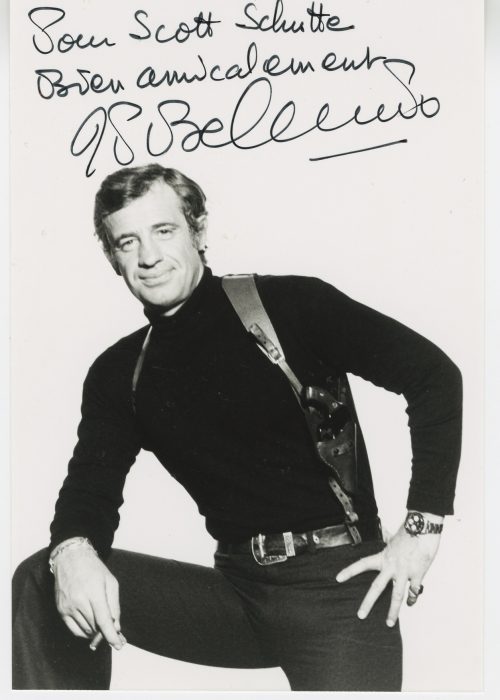 Three-quarter waist portrait of French actor Jean-Paul Belmondo in the film Peur sur la Ville, directed by Henri Verneuil in 1975. Autographed in black ink on a light area of the image above the head: “Pour Scott Schutte | Bien amicalement | J.P. Belmondo”. Paper watermarked "Agfa" in a diamond. Dimensions: 147 x 100 mm
Three-quarter waist portrait of French actor Jean-Paul Belmondo in the film Peur sur la Ville, directed by Henri Verneuil in 1975. Autographed in black ink on a light area of the image above the head: “Pour Scott Schutte | Bien amicalement | J.P. Belmondo”. Paper watermarked "Agfa" in a diamond. Dimensions: 147 x 100 mm -
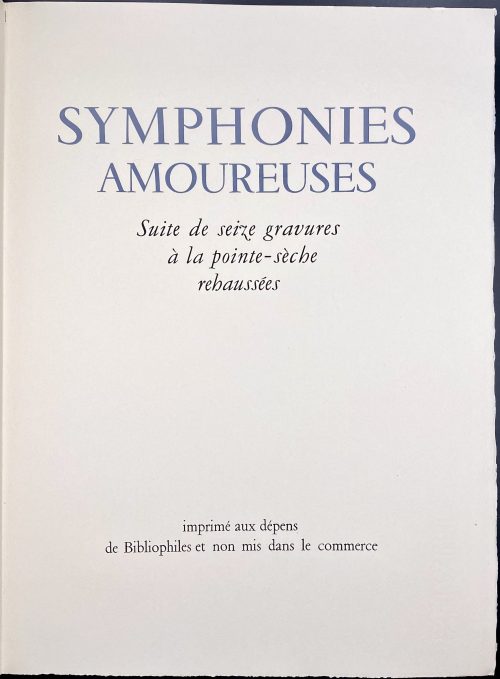 Description: Suite of 16 hand-coloured drypoints, in 39 x 29 cm, in cream French flapped wrappers with lavender lettering “SYMPHONIES AMOUREUSES” and a sanguine drypoint vignette (platemark 15 x 13 cm) to front, 17 leaves plus 2 leaves in the wrappers, 38.5 x 57 cm vertically folded once, lettering to one page, plate to another page, unbound, only the top margin trimmed, unpaginated, wove paper watermarked "BFK Rives", in a faux chagrin double slipcase 39.8 x 30 cm. Title-page (in lavender and black): SYMPHONIES AMOUREUSES | Suite de seize gravures | à la pointe sèche | rehaussées | {blank} | imprimé aux dépens | de Bibliophiles et non mis dans le commerce || Titles of the plates : 1. Ouverture. 2. Gamme. 3. Rêverie. 4. Pas redoublé. 5 Fantasia. 6. Pastorale. 7. Estudiantina. 8. Presto. 9. Arpège. 10. Menuet. 11 .Symphonie médiévale. 12. Jeux d’eau. 13. Galop. 14. Impromptu. 15. Variation. 16. Ariette. Limitation: Print run of 100 copies, 5 copies on Japon Manchou, numbered №№ 1-5, enriched; 11 copies on vélin à la forme de Rives, numbered №№ 6-16, enriched; 84 copies on vélin à la forme de Rives, numbered №№ 17-100, of which this is copy № 32. Cat. raisonné: Dutel III, № 2478. Contributors: André Collot (French, 1897 – 1976) – artist, engraver.
Description: Suite of 16 hand-coloured drypoints, in 39 x 29 cm, in cream French flapped wrappers with lavender lettering “SYMPHONIES AMOUREUSES” and a sanguine drypoint vignette (platemark 15 x 13 cm) to front, 17 leaves plus 2 leaves in the wrappers, 38.5 x 57 cm vertically folded once, lettering to one page, plate to another page, unbound, only the top margin trimmed, unpaginated, wove paper watermarked "BFK Rives", in a faux chagrin double slipcase 39.8 x 30 cm. Title-page (in lavender and black): SYMPHONIES AMOUREUSES | Suite de seize gravures | à la pointe sèche | rehaussées | {blank} | imprimé aux dépens | de Bibliophiles et non mis dans le commerce || Titles of the plates : 1. Ouverture. 2. Gamme. 3. Rêverie. 4. Pas redoublé. 5 Fantasia. 6. Pastorale. 7. Estudiantina. 8. Presto. 9. Arpège. 10. Menuet. 11 .Symphonie médiévale. 12. Jeux d’eau. 13. Galop. 14. Impromptu. 15. Variation. 16. Ariette. Limitation: Print run of 100 copies, 5 copies on Japon Manchou, numbered №№ 1-5, enriched; 11 copies on vélin à la forme de Rives, numbered №№ 6-16, enriched; 84 copies on vélin à la forme de Rives, numbered №№ 17-100, of which this is copy № 32. Cat. raisonné: Dutel III, № 2478. Contributors: André Collot (French, 1897 – 1976) – artist, engraver. -
 Saikotei Shibakuni (active 1821-1826). Osaka school. Play: Kinoshitakage Hazuma Gassen. Theatre: Nakamura-za /Naka-za (Osaka). Date: 7/1826. Horizontal oban diptych. SV: Nakamura Matsue III (Nakamura Tomijuro II) as female, Nakamura Utaemon III (Nakamura Shikan I) as a male. Publisher: Honya Seishichi [Marks 25-527 | 123f], Honsei, 1817-1838.
Saikotei Shibakuni (active 1821-1826). Osaka school. Play: Kinoshitakage Hazuma Gassen. Theatre: Nakamura-za /Naka-za (Osaka). Date: 7/1826. Horizontal oban diptych. SV: Nakamura Matsue III (Nakamura Tomijuro II) as female, Nakamura Utaemon III (Nakamura Shikan I) as a male. Publisher: Honya Seishichi [Marks 25-527 | 123f], Honsei, 1817-1838. -
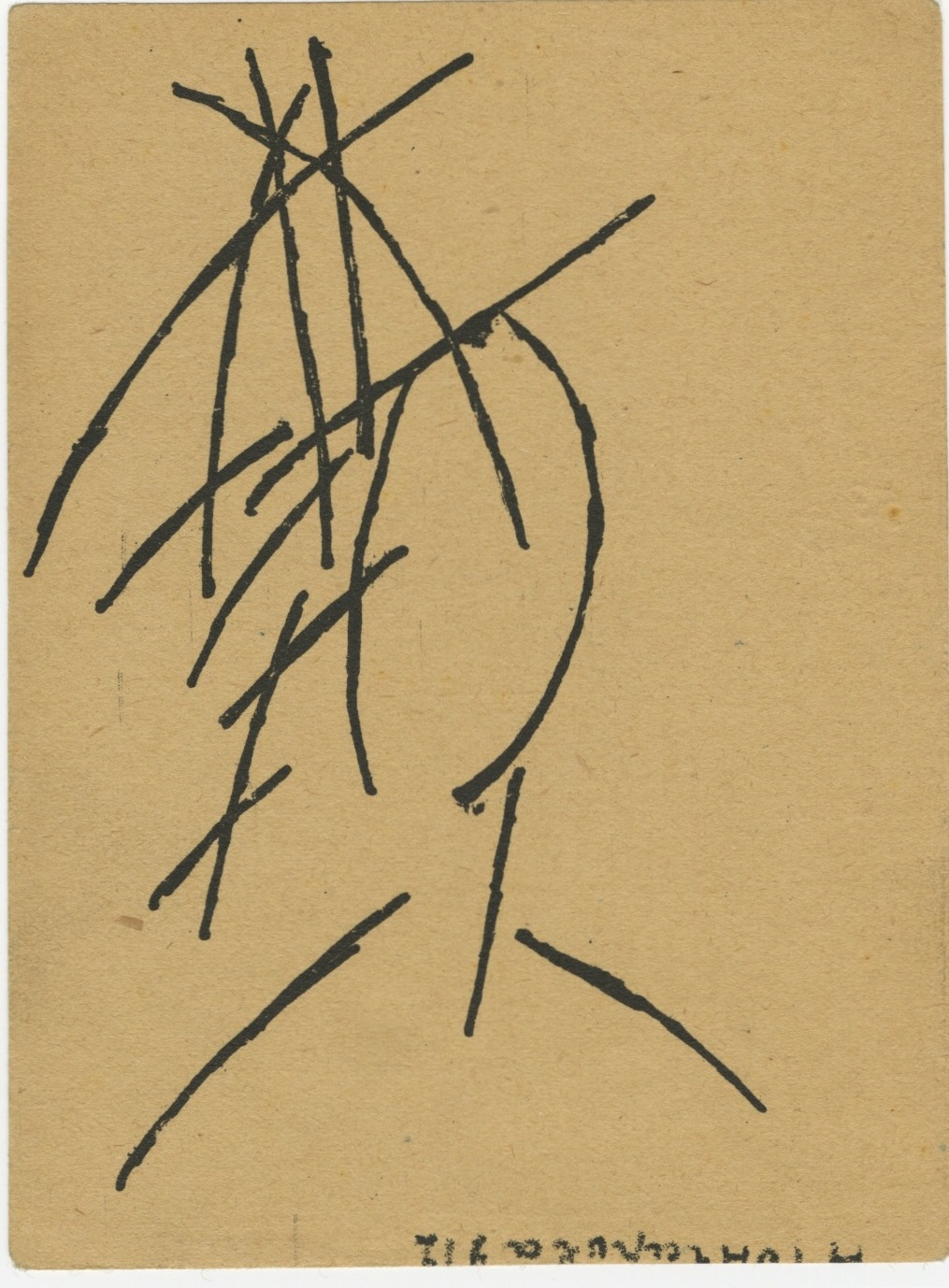 Artist: Mikhail Larionov (June 3, 1881 – May 10, 1964) ). Russian/French. Lithographic illustration "Woman in a hat" for Aleksei Kruchenykh book "Lipstick", Moscow, Kuzmin and Dolinsky Publishers, 1913, 480 copies printed. Size: 11,3 х 8,2 cm. Михаил Ларионов (3 июня 1881 – 10 мая 1964). Россия/Франция. Литографическая иллюстрация "Женщина в шляпе" к книге Алексея Крученых "Помада"; М.: Изд. Г.Л. Кузьмина и С.Д. Долинского, 1913, отпечатана в 480 экз. Формат: 11,3 х 8,2 см.
Artist: Mikhail Larionov (June 3, 1881 – May 10, 1964) ). Russian/French. Lithographic illustration "Woman in a hat" for Aleksei Kruchenykh book "Lipstick", Moscow, Kuzmin and Dolinsky Publishers, 1913, 480 copies printed. Size: 11,3 х 8,2 cm. Михаил Ларионов (3 июня 1881 – 10 мая 1964). Россия/Франция. Литографическая иллюстрация "Женщина в шляпе" к книге Алексея Крученых "Помада"; М.: Изд. Г.Л. Кузьмина и С.Д. Долинского, 1913, отпечатана в 480 экз. Формат: 11,3 х 8,2 см.








